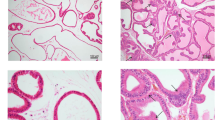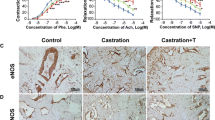Abstract
Objectives
It has been reported that apoptosis of penile erectile tissue occurs after penile denervation, castration, and diabetes mellitus in animal studies. Aim of this study was to investigate apoptosis in corpora cavernosa of patients with organic erectile dysfunction (ED).
Methods
Cavernous biopsies were obtained from 38 patients with erectile dysfunction and 10 patients with normal erectile function. Apoptosis of tissues were determined via terminal deoxyuridine nucleotide end labeling method by using flow cytometry.
Results
The mean ages of patients with ED and control patients were 50.65 ± 2.27, and 32.43 ± 2.90 years, respectively (P = 0.0001). Patients with ED were set in two groups as more than 50 years old and less than 50 years old for further analysis of age factor on apoptosis. The mean % apoptosis of ED patients was 26.22 ± 2.79 and control group was 11.26 ± 3.79, (P = 0.032). Mean fluorescence intensity (MFI) values were also 17.41 ± 3.21 and 6.59 ± 2.28, respectively (P = 0.039). MFI and % apoptosis values were not statistically significant different neither between the patients groups nor between the control and patients ≤50 years old (P > 0.05).
Conclusions
We did not find any statistically significant difference with respect to apoptosis rates when we compared neither control group with ≤50 years old patients nor patients groups of ED. Because of this we did not have enough data to say that apoptosis has a prominent role on the development of ED independently from other factors. However, further studies are necessary to clarify the role of apoptosis in erectile dysfunction.

Similar content being viewed by others
References
NIH Consensus Conference (1993) Impotence. NIH Consensus Development Panel on Impotence. JAMA 270:83–90
Feldman HA, Goldstein I, Hatzichristou DG, Krane RJ, McKinlay JB (1994) Impotence and its medical and psychosocial correlates: results of the Massachusetts male aging study. J Urol 151:54–61
Cummings MC, Winterford CM, Walker NI (1997) Apoptosis. Am J Surg Pathol 21:88–101
Alıcı B, Gümüştaş MK, Özkara H, Demirel G, Yencilek F, Hattat H (2000) Apoptosis in the erectile tissues of diabetic and healthy rats. BJU Int 85:326–329
Hetts SW (1998) To die or not to die. An overview of apoptosis and its role in disease. JAMA 279:300–307
Liu LC, Huang CH, Huang YL, Chiang CP, Chou YH, Liu LH, Shieh SR, Lu PS (1993) Ultrastructural features of penile tissue in impotent men. Br J Urol 72:635–642
Mersdorf A, Goldsmith PC, Diederichs W, Padula CA, Lue TF, Fishman IJ, Tanagho EA (1991) Ultrastructural changes in impotent penile tissue: a comparison of 65 patients. J Urol 145:749–758
Persson C, Diederichs W, Lue TF, Yen TS, Fishman IJ, McLin PH, Tanagho EA (1989) Correlation of altered penile ultrastructure with clinical evaluation. J Urol 142:1462–1468
Nehra A, Goldstein I, Pabby A, Nugent M, Huang YH, de las Morenas A, Krane RJ, Udelson D, Saenz de Tejada I, Moreland RB (1996) Mechanisms of venous leakage: a prospective clinicopathological correlation of corporeal function and structure. J Urol 156:1320–1329
Grilli A, De Lutiis MA, Patruno A, Speranza L, Cataldi A, Centurione L, Taccardi AA, Di Napoli P, De Caterina R, Barbacane R, Conti P, Felaco M (2003) Effect of chronic hypoxia on inducible nitric oxide synthase expression in rat myocardial tissue. Exp Biol Med 228:935–942
Ferrini M, Magee TR, Vernet D, Rajfer J, Gonzalez-Cadavid NF (2001) Aging-related expression of inducible nitric oxide synthase and markers of tissue damage in the rat penis. Biol Reprod 64:974–982
Hammond EM, Giaccia AJ (2005) The role of p53 in hypoxia-induced apoptosis. Biochem Biophys Res Commun 331:718–725
Klein LT, Miller MI, Buttyan R, Raffo AJ, Burchard M, Devris G, Cao YC, Olsson C, Shabsigh R (1997) Apoptosis in the rat penis after penile denervation. J Urol 158:626–630
Podlasek CA, Zelner DJ, Harris JD, Meroz CL, Tang Y, McKenna KE, McVary KT (2003) Altered Sonic hedgehog signaling is associated with morphological abnormalities in the penis of the BB/WOR diabetic rat. Biol Reprod 69:816–827
User HM, Hairston JH, Zelner DJ, McKenna KE, McVary KT (2003) Penile weight and cell subtype specific changes in a post-radical prostatectomy model of erectile dysfunction. J Urol 169:1175–1179
Yamanaka M, Shirai M, Shiina H, Tanaka Y, Tsujimura A, Matsumiya K, Okuyama A, Dahiya R (2003) Diabetes induced erectile dysfunction and apoptosis in penile crura are recovered by insulin treatment in rats. J Urol 170:291–297
Yamamoto H, Sasaki S, Tatsura H, Umemoto Y, Kubota H, Kamiya H, Kawai T, Kang K, Kohri K (2004) Penile apoptosis in association with p53 under lack of testosterone. Urol Res 32:9–13
Zhang XH, Hu LQ, Zheng XM, Li SW (1999) Apoptosis in rat erectile tissue induced by castration. Asian J Androl 1:181–185
Hatzichristou DG, Hatzimouratidis K, Apostolidis A, Ioannidis E, Yannakoyorgos K, Kalinderis A (1999) Hemodynamic characterization of a functional erection. Arterial and corporeal veno-occlusive function in patients with a positive intracavernosal injection test. Eur Urol 36:60–67
Heiden T, Castanos-Velez E, Andersson LC, Biberfeld P (2000) Combined analysis of DNA ploidy, proliferation, and apoptosis in paraffin-embedded cell material by flow cytometry. Lab Invest 80:1207–1213
Park KH, Kim SW, Kim KD (1999) Effects of androgens on the expression of nitric oxide synthase mRNAs in rat corpus cavernosum. BJU Int 83:327–333
Seftel AD (2003) Erectile dysfunction in the elderly: epidemiology, etiology and approaches to treatment. J Urol 169:1999–2007
Corona G, Mannucci E, Mansani R, Petrone L, Bartolini M, Giommi R, Mancini M, Forti G, Maggi M (2004) Aging and pathogenesis of erectile dysfunction. Int J Impot Res 16:395–402
Beutel ME, Wiltink J, Hauck EW, Auch D, Behre HM, Brähler E, Weidner W (2005) Correlations between hormones, physical, and affective parameters in aging urologic outpatients. Eur Urol 47:749–755
Garban H, Vernet D, Freedman A, Rajfer J, Gonzalez-Cadavid N (1995) Effect of aging on nitric oxide-mediated penile erection in rats. Am J Physiol 268:H467–H475
Cartledge JJ, Eardley I, Morrison JF (2001) Nitric oxide-mediated corpus cavernosal smooth muscle relaxation is impaired in ageing and diabetes. BJU Int 87:394–401
Carrier S, Nagaraju P, Morgan DM, Baba K, Nunes L, Lue TF (1997) Age decreases nitric oxide synthase containing nerve fibers in the rat penis. J Urol 157:1088–1092
Jin L, Liu T, Lagoda GA, Champion HC, Bivalacqua TJ, Burnett AL (2006) Elevated RhoA/Rho-kinase activity in the aged rat penis: mechanism for age-associated erectile dysfunction. FASEB J 20:536–538
Wespes E, Moreira de Goes P, Schulman CC (1998) Age-related changes in the quantification of the intracavernous smooth muscles in potent men (Abstract). J Urol 159:379
Lin JS, Lin YM, Chow NH, Wang ST, Sun YN (2000) Novel image analysis of corpus cavernous tissue in impotent men. Urology 55:252–256
Akkus E, Carrier S, Baba K, Hsu GL, Padma-Nathan H, Nunes L, Lue TF (1997) Structural alterations in the tunica albuginea of the penis: impact of Peyronie’s disease, aging and impotence. Br J Urol 79:47–53
Dahiya R, Chui R, Perinchery G, Nakajima K, Oh BR, Lue TF (1999) Differential gene expression of growth factors in young and old rat penile tissues is associated with erectile dysfunction. Int J Impot Res 11:201–206
Yamanaka M, Shirai M, Shiina H, Shirai M, Tanaka Y, Fujime M, Okuyama A, Dahiya R (2002) Loss of anti-apoptotic genes in aging rat crura. J Urol 168:2296–2300
Seftel AD, Maclennan GT, Chen ZJ, Liu S, Ferguson K, Deoreo G, Levine F, Hampel N, Ho-Chang C (1999) Loss of TGF B, Apoptosis, and Bcl-2 in erectile dysfunction and upregulation of p53 and HIF-1 alpha in diabetes-associated erectile dysfunction. Mol Urol 3:103–107
Conflict of interest statement
There is no conflict of interest.
Author information
Authors and Affiliations
Corresponding author
Rights and permissions
About this article
Cite this article
Tarhan, F., Demirel, G.Y., Kuyumcuoğlu, U. et al. Apoptosis of corpus cavernosum in patients with organic erectile dysfunction. World J Urol 27, 235–240 (2009). https://doi.org/10.1007/s00345-008-0332-6
Received:
Accepted:
Published:
Issue Date:
DOI: https://doi.org/10.1007/s00345-008-0332-6




